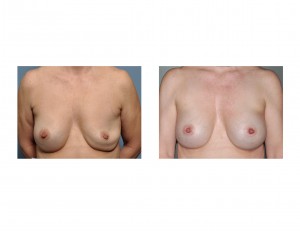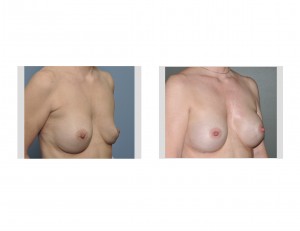Background: Breast augmentation can be done by two types of implants, saline and silicone. Since silicone implants have become available again nearly eight years ago in 2006, the percentage of women undergoing breast enhancement receiving saline implants has been slowly declining. But saline implants will always be around as, at the least, they offer the most economical option to have one’s breasts enlarged.
Like all breast implants, saline implants have a limited lifespan and will eventually one day ‘fail’. Failure in a saline implant is defined as a catastrophic event in which the implant deflates due to loss of integrity of the shell (a hole) and the escape of its saline contents. When that will occur after their initial placement is unknown and could be anywhere from months to decades. Although on average a good estimate of their lifespan would be ten to twenty years.
No woman probably ever really believes that her breast implants will fail or need to be replaced, but eventually that day does come. And with a ‘flat tire’ that usually accompanies saline implant failure, the decision as to what to do when it happens comes quickly and unexpectantly. But as with every negative experience comes the opportunity to end up even better than where one started.
Case Study: This 54 year-old female presented with a flat breast on one side that had spontaneously appeared without any precipitating event. She had saline breast implants placed twenty-one years previously in a submuscular position. She had an obvious saline deflation which was both silent and immediate. Her decisions about new breast implants revolved around whether to replace only the deflated one, both implants with new saline devices, both implants with new silicone devices and whether to increase the implant size or to stay the same.


While saline implant failure can be discouraging, even if it is inevitable, there is some good news about it. Breast implant replacement can be virtually painless with no to minimal recovery. The existence of an established breast pocket and a fully formed capsular lining means little tissue dissection needs to be done. Thus the implants can be put in quickly and painlessly and, in some patients, even under local anesthesia with a little sedation. To eliminate the risk of subsequent implant deflation, silicone gel implants can be used which will never suffer a catastrophic deflation event. One can also increase or decrease implant size as one desires. Although to maintain the same implant size due to some breast tissue loss and tissue relaxation, it is advised to increase implant volume by 10% to 20%.
Case Highlights:
1) Saline breast implants are not lifelong devices and have an indeterminate lifespan before catastrophic failure.
2) Breast implant replacement has a much easier recovery than the initial breast augmentation procedure.
3) Saline breast implant failure offers the opportunity to change implant type, size or even projection.
Dr. Barry Eppley
Indianapolis, Indiana


